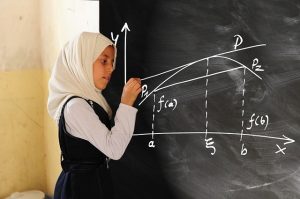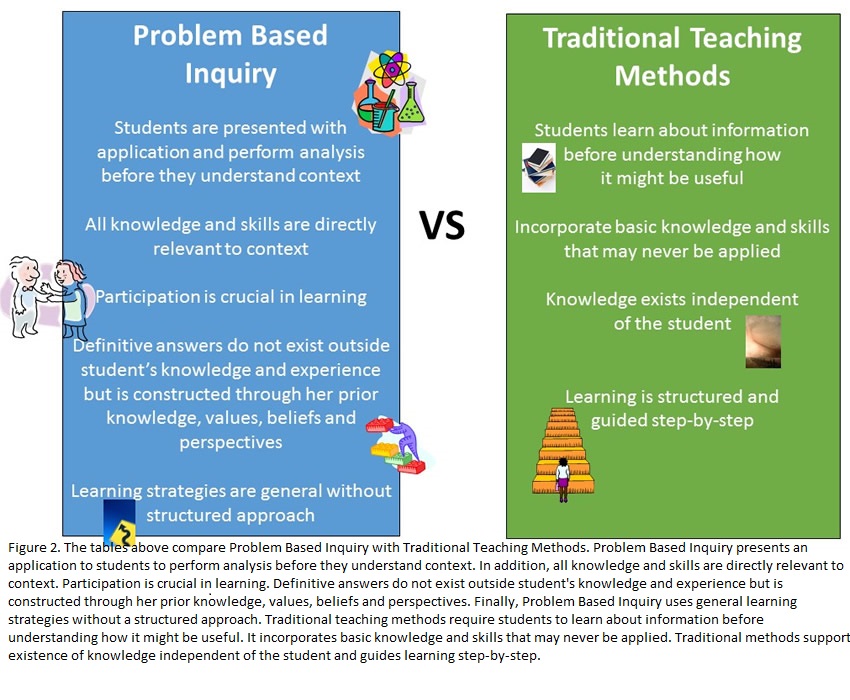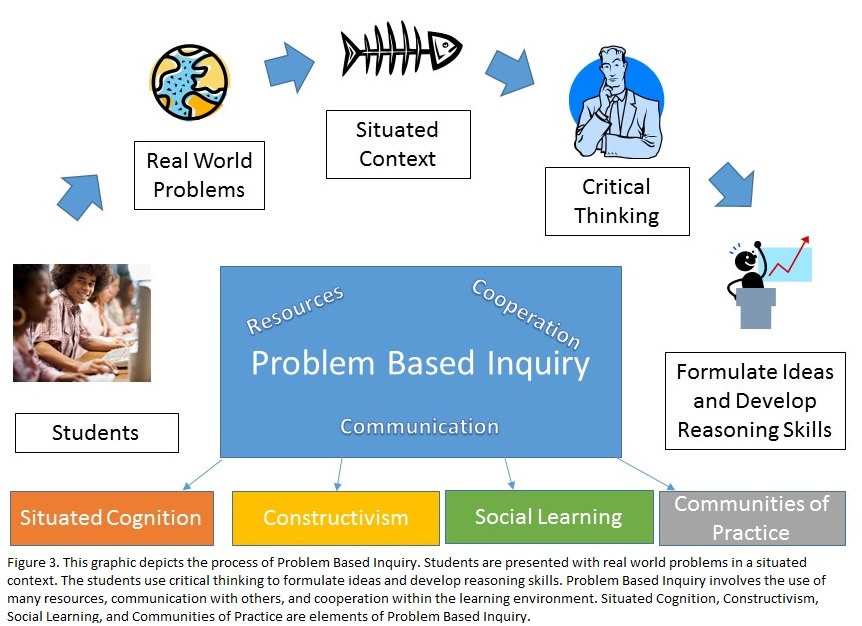Ch. 5 Problem Based Learning
Evan Glazer (University of Georgia)

Editor’s Note: Dr. Glazer chose to use the term Problem-based Instruction and Inquiry, but my reading and other references to this chapter also use the term Problem-based Learning. The reader can assume the terms are equivalent.
Description
- Problem-based inquiry is an effort to challenge students to address real-world problems and resolve realistic dilemmas.
Such problems create opportunities for meaningful activities that engage students in problem solving and higher-ordered thinking in authentic settings. Many textbooks attempt to promote these skills through contrived settings without relevance to students’ lives or interests. A notorious algebra problem concerns the time at which two railway trains will pass each other:
Two trains leave different stations headed toward each other. Station A is 500 miles west of Station B. Train A leaves station A at 12:00 pm traveling toward Station B at a rate of 60 miles per hour. Train B leaves Station B at 2:30 pm for Station A at a rate of 45 miles per hour. At what time will the trains meet?
Reading this question, one might respond, “Who cares?”, or, “Why do we need to know this?” Such questions have created substantial anxiety among students and have, perhaps, even been the cause of nightmares. Critics would argue that classic “story problems” leave a lasting impression of meaningless efforts to confuse and torment students, as if they have come from hell’s library. Problem-based inquiry, on the other hand, intends to engage students in relevant, realistic problems.
Several changes would need to be made in the above problem to promote problem-based inquiry. It would first have to be acknowledged that the trains are not, in fact, traveling at constant rates when they are in motion; negotiating curves or changing tracks at high speeds can result in accidents.
Further, all of the information about the problem cannot be presented to the learner at the outset; that is, some ambiguity must exist in the context so that students have an opportunity to engage in a problem-solving activity. In addition, the situation should involve a meaningful scenario. Suppose that a person intends to catch a connecting train at the second station and requires a time-efficient itinerary? What if we are not given data about the trains, but instead, the outcome of a particular event, such as an accident?
Why should we use problem-based inquiry to help students learn?
The American educational system has been criticized for having an underachieving curriculum that leads students to memorize and regurgitate facts that do not apply to their lives (Martin, 1987; Paul, 1993). Many claim that the traditional classroom environment, with its orderly conduct and didactic teaching methods in which the teacher dispenses information, has greatly inhibited students’ opportunities to think critically (Dossey et al., 1988; Goodlad, 1984; Wood, 1987). Problem-based inquiry is an attempt to overcome these obstacles and confront the concerns presented by the National Assessment of Educational Progress:
If an unfriendly foreign power had attempted to impose on America the mediocre educational performance that exists today, we might well have viewed it as an act of war. We have, in effect, been committing an act of unthinking, unilateral educational disarmament. (A Nation at Risk, 1983)
Problem-based inquiry emphasizes learning as a process that involves problem solving and critical thinking in situated contexts. It provides opportunities to address broader learning goals that focus on preparing students for active and responsible citizenship. Students gain experience in tackling realistic problems, and emphasis is placed on using communication, cooperation, and resources to formulate ideas and develop reasoning skills.
What is a framework for a problem-based inquiry?
Situated cognition, constructivism, social learning, and communities of practice are assumed theories of learning and cognition in problem-based inquiry environments. These theories have common themes about the context and the process of learning and are often associated.

Characteristics
Some common characteristics in problem-based learning models:
Activity is grounded in a general question about a problem that has multiple possible answers and methods for addressing the question. Each problem has a general question that guides the overall task followed by ill-structured problems or questions that are generated throughout the problem-solving process. That is, to address the larger question, students must derive and investigate smaller problems or questions that relate to the findings and implications of the broader goal. The problems or questions thus created are most likely new to the students and lack known definitive methods or answers that have been predetermined by the teacher.
Learning is student-centered; the teacher acts as facilitator. In essence, the teacher creates an environment where students take ownership in the direction and content of their learning.
Students work collaboratively towards addressing the general question. All of the students work together to attain the shared goal of producing a solution to the problem. Consequently, the groups co-depend on each other’s performance and contributions in order to make their own advances in reasoning toward answering the research questions and the overall problem.
Learning is driven by the context of the problem and is not bound by an established curriculum. In this environment, students determine what and how much they need to learn in order to accomplish a specific task. Consequently, acquired information and learned concepts and strategies are tied directly to the context of the learning situation. Learning is not confined to a preset curriculum. Creation of a final product is not a necessary requirement of all problem-based inquiry models.
Project-based learning models most often include this type of product as an integral part of the learning process, because learning is expected to occur primarily in the act of creating something. Unlike problem based inquiry models, project-based learning does not necessarily address a real-world problem, nor does it focus on providing argumentation for resolution of an issue.
In a problem-based inquiry setting, there is greater emphasis on problem-solving, analysis, resolution, and explanation of an authentic dilemma. Sometimes this analysis and explanation is represented in the form of a project, but it can also take the form of verbal debate and written summary.
Instructional models and applications
- There is no single method for designing problem-based inquiry learning environments.
Various techniques have been used to generate the problem and stimulate learning. Promoting student-ownership, using a particular medium to focus attention, telling stories, simulating and recreating events, and utilizing resources and data on the Internet are among them. The instructional model, problem based learning will be discussed next with attention to instructional strategies and practical examples.
Problem-Based Learning
- Problem-based learning (PBL) is an instructional strategy in which students actively resolve complex problems in realistic situations.
It can be used to teach individual lessons, units, or even entire curricula. PBL is often approached in a team environment with emphasis on building skills related to consensual decision making, dialogue and discussion, team maintenance, conflict management, and team leadership. While the fundamental approach of problem solving in situated environments has been used throughout the history of schooling, the term PBL did not appear until the 1970s and was devised as an alternative approach to medical education.
In most medical programs, students initially take a series of fact intensive courses in biology and anatomy and then participate in a field experience as a medical resident in a hospital or clinic. However, Barrows reported that, unfortunately, medical residents frequently had difficulty applying knowledge from their classroom experiences in work-related, problem-solving situations. He argued that the classical framework of learning medical knowledge first in classrooms through studying and testing was too passive and removed from context to take on meaning.
Consequently, PBL was first seen as a medical field immersion experience whereby students learned about their medical specialty through direct engagement in realistic problems and gradual apprenticeship in natural or simulated settings. Problem solving is emphasized as an initial area of learning and development in PBL medical programs more so than memorizing a series of facts outside their natural context.
In addition to the field of medicine, PBL is used in many areas of education and training. In academic courses, PBL is used as a tool to help students understand the utility of a particular concept or study. For example, students may learn about recycling and materials as they determine methods that will reduce the county landfill problem.
In addition, alternative education programs have been created with a PBL emphasis to help at-risk students learn in a different way through partnerships with local businesses and government. In vocational education, PBL experiences often emphasize participation in natural settings.
For example, students in architecture address the problem of designing homes for impoverished areas. Many of the residents need safe housing and cannot afford to purchase typical homes. Consequently, students learn about architectural design and resolving the problem as they construct homes made from recycled materials. In business and the military, simulations are used as a means of instruction in PBL. The affective and physiological stress associated with warfare can influence strategic planning, so PBL in military settings promotes the use of “war games” as a tactic for facing authentic crises.
In business settings, simulations of “what if” scenarios are used to train managers in various strategies and problem-solving approaches to conflict resolution. In both military and business settings, the simulation is a tool that provides an opportunity to not only address realistic problems but to learn from mistakes in a more forgiving way than in an authentic context.
Designing the learning environment
The following elements are commonly associated with PBL activities.

Problem generation: The problems must address concepts and principles relevant to the content domain. Problems are not investigated by students solely for problem solving experiences but as a means of understanding the subject area. Some PBL activities incorporate multidisciplinary approaches, assuming the teacher can provide and coordinate needed resources such as additional content, instructional support, and other teachers. In addition, the problems must relate to real issues that are present in society or students’ lives. Contrived scenarios detract from the perceived usefulness of a concept.
Problem presentation: Students must “own” the problem, either by creating or selecting it. Ownership also implies that their contributions affect the outcome of solving the problem. Thus, more than one solution and more than one method of achieving a solution to the problem are often possible. Furthermore, ownership means that students take responsibility for representing and communicating their work in a unique way.
Predetermined formats of problem structure and analysis towards resolution are not recommended; however, the problem should be presented such that the information in the problem does not call attention to critical factors in the case that will lead to immediate resolution. Ownership also suggests that students will ask further questions, reveal further information, and synthesize critical factors throughout the problem-solving process.
Teacher role: Teachers act primarily as cognitive coaches by facilitating learning and modeling higher order thinking and meta cognitive skills. As facilitators, teachers give students control over how they learn and provide support and structure in the direction of their learning. They help the class create a common framework of expectations using tools such as general guidelines and time lines.
As cognitive modelers, teachers think aloud about strategies and questions that influence how students manage the progress of their learning and accomplish group tasks. In addition, teachers continually question students about the concepts they are learning in the context of the problem in order to probe their understanding, challenge their thinking, and help them deepen or extend their ideas.
Student role: Students first define or select an ill-structured problem that has no obvious solution. They develop alternative hypotheses to resolve the problem and discuss and negotiate their conjectures in a group. Next, they access, evaluate, and utilize data from a variety of available sources to support or refute their hypotheses. They may alter, develop, or synthesize hypotheses in light of new information. Finally, they develop clearly stated solutions that fit the problem and its inherent conditions, based upon information and reasoning to support their arguments. Solutions can be in the form of essays, presentations, or projects.
Maine School Engages Kids With Problem-Solving Challenges (11:37)
[PBS NewsHour].(2013, May 6). Maine School Engages Kids with Problem Solving Challenges. [Video File]. Retrieve from https://youtu.be/i17F-b5GG94
Special correspondent John Tulenko of Leaning Matters reports on a public middle school in Portland, Maine that is taking a different approach to teaching students. Teachers have swapped traditional curriculum for an unusually comprehensive science curriculum that emphasizes problem-solving, with a little help from some robots.
Effectiveness of Problem and Inquiry-based learning.
Why does inquiry-based learning only have an effect size of 0.31 when it is an approach to learning that seems to engage students and teachers so readily in the process of learning?
When is the right and wrong time to introduce inquiry and problem based learning?
Watch video from John Hattie on inquiry and problem-based learning, (2:11 minutes).
[Corwin]. (2015, Nov. 9). John Hattie on inquiry-based learning. [Video File]. Retrieved from https://youtu.be/YUooOYbgSUg.
References
Glazer, E. (2010) Emerging Perspectives on Learning, Teaching, and Technology, Global Text, Michael Orey. (Chapter 14) Attribution CC 3.0. Retrieved from https://textbookequity.org/Textbooks/Orey_Emerging_Perspectives_Learning.pdf

